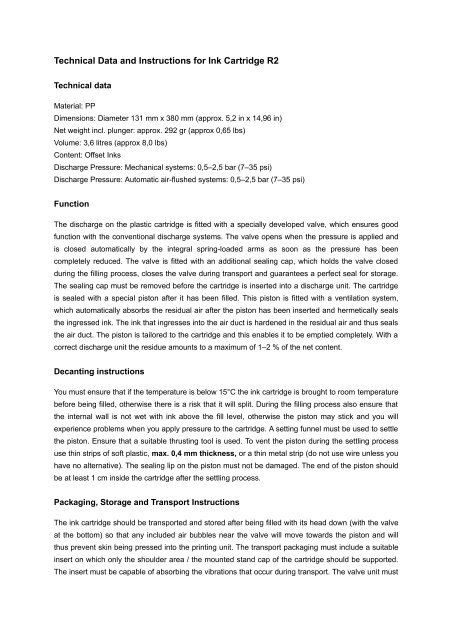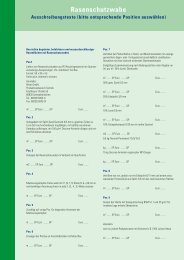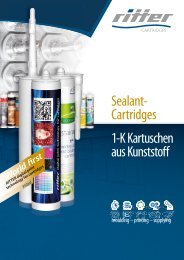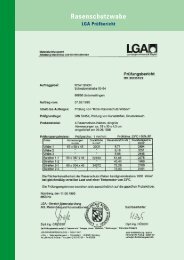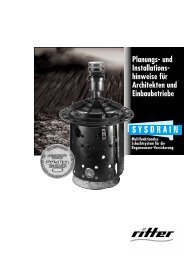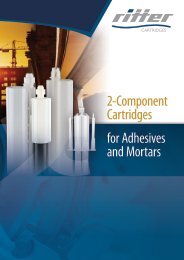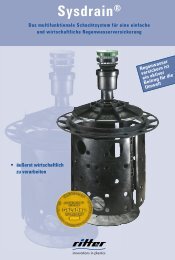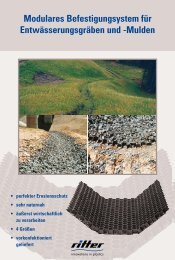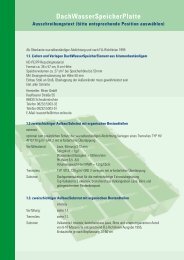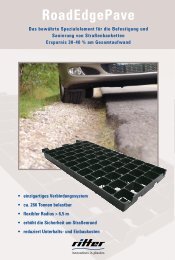Technical Data and Instructions for Ink Cartridge R2 - Ritter
Technical Data and Instructions for Ink Cartridge R2 - Ritter
Technical Data and Instructions for Ink Cartridge R2 - Ritter
You also want an ePaper? Increase the reach of your titles
YUMPU automatically turns print PDFs into web optimized ePapers that Google loves.
<strong>Technical</strong> <strong>Data</strong> <strong>and</strong> <strong>Instructions</strong> <strong>for</strong> <strong>Ink</strong> <strong>Cartridge</strong> <strong>R2</strong><br />
<strong>Technical</strong> data<br />
Material: PP<br />
Dimensions: Diameter 131 mm x 380 mm (approx. 5,2 in x 14,96 in)<br />
Net weight incl. plunger: approx. 292 gr (approx 0,65 lbs)<br />
Volume: 3,6 litres (approx 8,0 lbs)<br />
Content: Offset <strong>Ink</strong>s<br />
Discharge Pressure: Mechanical systems: 0,5–2,5 bar (7–35 psi)<br />
Discharge Pressure: Automatic air-flushed systems: 0,5–2,5 bar (7–35 psi)<br />
Function<br />
The discharge on the plastic cartridge is fitted with a specially developed valve, which ensures good<br />
function with the conventional discharge systems. The valve opens when the pressure is applied <strong>and</strong><br />
is closed automatically by the integral spring-loaded arms as soon as the pressure has been<br />
completely reduced. The valve is fitted with an additional sealing cap, which holds the valve closed<br />
during the filling process, closes the valve during transport <strong>and</strong> guarantees a perfect seal <strong>for</strong> storage.<br />
The sealing cap must be removed be<strong>for</strong>e the cartridge is inserted into a discharge unit. The cartridge<br />
is sealed with a special piston after it has been filled. This piston is fitted with a ventilation system,<br />
which automatically absorbs the residual air after the piston has been inserted <strong>and</strong> hermetically seals<br />
the ingressed ink. The ink that ingresses into the air duct is hardened in the residual air <strong>and</strong> thus seals<br />
the air duct. The piston is tailored to the cartridge <strong>and</strong> this enables it to be emptied completely. With a<br />
correct discharge unit the residue amounts to a maximum of 1–2 % of the net content.<br />
Decanting instructions<br />
You must ensure that if the temperature is below 15°C the ink cartridge is brought to room temperature<br />
be<strong>for</strong>e being filled, otherwise there is a risk that it will split. During the filling process also ensure that<br />
the internal wall is not wet with ink above the fill level, otherwise the piston may stick <strong>and</strong> you will<br />
experience problems when you apply pressure to the cartridge. A setting funnel must be used to settle<br />
the piston. Ensure that a suitable thrusting tool is used. To vent the piston during the settling process<br />
use thin strips of soft plastic, max. 0,4 mm thickness, or a thin metal strip (do not use wire unless you<br />
have no alternative). The sealing lip on the piston must not be damaged. The end of the piston should<br />
be at least 1 cm inside the cartridge after the settling process.<br />
Packaging, Storage <strong>and</strong> Transport <strong>Instructions</strong><br />
The ink cartridge should be transported <strong>and</strong> stored after being filled with its head down (with the valve<br />
at the bottom) so that any included air bubbles near the valve will move towards the piston <strong>and</strong> will<br />
thus prevent skin being pressed into the printing unit. The transport packaging must include a suitable<br />
insert on which only the shoulder area / the mounted st<strong>and</strong> cap of the cartridge should be supported.<br />
The insert must be capable of absorbing the vibrations that occur during transport. The valve unit must
not be placed or strike against the base since this can cause malfunctions or, in cool temperature, may<br />
even result in the valve being broken. The cartridge being delivered with mounted bajonet cap, it is<br />
essential that there is sufficient space between the valve unit <strong>and</strong> the base of the packaging. In<br />
addition the transport packaging must have a suitable protective insert to ensure that the ink cartridges<br />
can not come into contact with each other.<br />
<strong>Instructions</strong> <strong>for</strong> Printers<br />
Ensure that the ink cartridge is stored properly. After opening the top of the packaging, you can see<br />
whether this is the case by the piston side of the ink cartridge pointing upwards. Be<strong>for</strong>e use, the ink<br />
cartridge should be brought to room temperature. Be<strong>for</strong>e you insert the ink cartridge into a discharge<br />
system the sealing cap must be removed. We recommend that you use pneumatic discharge units<br />
with compressed air circulation to ensure optimal wiper results by the piston. Mechanical discharge<br />
units, depending on their design, may result in the deterioration of the wiping properties of the piston<br />
as a result of the instability of the unit <strong>and</strong> excessive operating pressure. Be<strong>for</strong>e you insert an ink<br />
cartridge into a discharge unit, conduct a visual inspection <strong>for</strong> signs of damage or leaks around the<br />
valve. Also, inspect carefully whether the cartrigde shows stress marks (white lines) or de<strong>for</strong>mations<br />
on the cartridge body due to the transport be<strong>for</strong>e you apply it on an automatic ink-feed system. In this<br />
case, <strong>and</strong> if leaking occurs past the piston, do not use the concerned cartrigde. If after use the<br />
cartridge retains some ink, then after removing it, clean the ink discharge area near the valve very<br />
carefully <strong>and</strong> reside the sealing cap. Use partly emptied cartridges alternately. If you wish to use a<br />
partly emptied cartridge again, ensure that there is no dried ink on the valve. Any skin should be<br />
removed be<strong>for</strong>e use.<br />
If you have any further questions on this subject, please do not hesitate to contact the<br />
following:<br />
Germany: <strong>Ritter</strong> GmbH<br />
Sales Dept.: Andreas Ruf<br />
Phone: +49-8232-500327<br />
E-Mail: <strong>and</strong>reas.ruf@ritter-online.de<br />
Technics: Christian Mößnang<br />
Phone: +49-8232-5003-75<br />
E-Mail: christian.moessnang@ritter-online.de


